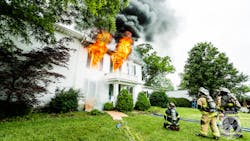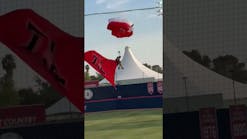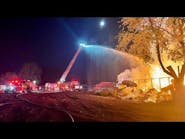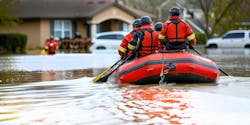UL FSRI Releases Report on Coordinated Fire Attack in Single-Family Homes
March 19, 2020 —The UL Firefighter Safety Research Institute (FSRI) has released a new research report, “Analysis of the Coordination of Suppression and Ventilation in Single-Family Homes” based on the first series of experiments conducted as part of the “Study of Coordinated Fire Attack Utilizing Acquired Structures.” This project was funded by the U.S. Department of Homeland Security (DHS) and Federal Emergency Management Agency (FEMA) Assistance to Firefighters Grant Program.
The purpose of this study is to increase fire service knowledge of fire dynamics and the impact of firefighting tactics through a better understanding of how suppression and ventilation are coordinated on the fireground in acquired residential structures. Specifically, the goal is to better understand the science behind fire attack coordination and how firefighting tactics may link together to create a positive outcome for occupant survivability, firefighter safety, and property conservation.
In conjunction with the fire service project technical panel, UL FSRI engineers developed and then conducted a series of 20 experiments designed to evaluate fire control strategies for both second-floor bedroom fires (14 experiments) and first-floor kitchen fires (6 experiments). These acquired structure experiments were conducted in collaboration with the City of Sidney Fire Department (Sidney, OH) and the Beavercreek Township Fire Department (Beavercreek, OH).
Utilizing eight single-family homes, these experiments brought the laboratory to the street. Tactics tested include horizontal, vertical, and positive pressure ventilation combined with interior or interior/exterior suppression. Through our partnership with the Illinois Fire Service Institute (IFSI), UL FSRI also looked to better understand firefighter and occupant exposure and the correlation to the coordination of firefighting tactics.
This report provides fire dynamics analysis of each of the experiments, a discussion of the different control strategies examined, and tactical considerations developed with the project technical panel.
“It's very important for us to be able to have fire service partners such as the Sidney and Beavercreek Township Fire Departments that allow us to do these experiments outside of the lab. Without their support, we would not have been able to get these structures and conduct this research. We could not have done this on our own,” said Stephen Kerber, Vice President, Research, UL FSRI. “Since the UL FSRI team returned from the experiments in Ohio, they have been pouring through data and video, working with our technical panel, and preparing the results to hit the street so that this research can have the greatest impact on firefighter safety and effectiveness.”
Two more reports, which focus on the multi-family residential and commercial structure experiments conducted for this study will follow soon. Additionally, online courses are being developed and will be available through the UL FSRI Fire Safety Academy.
For a behind-the-scenes look, watch the video below:
Access the report here.
About UL Firefighter Safety Research Institute
UL Firefighter Safety Research Institute (FSRI) advances fire research knowledge and develops cutting edge, practical fire service education aimed at helping firefighters stay safe while more effectively protecting people and property. Guided by a global advisory board comprised of fire service personnel, UL FSRI investigates residential, commercial, and industrial fires through full-scale testing, field-testing, and modeling to replicate actual fires faced by firefighters. Research results are shared through interactive training courses that have reached hundreds of thousands of firefighters globally. To learn more, visit ULFirefighterSafety.org. Follow UL Firefighter Safety Research Institute on Twitter, Instagram and Facebook.
About Underwriters Laboratories
Underwriters Laboratories is a nonprofit organization dedicated to advancing the UL public safety mission through the discovery and application of scientific knowledge. We conduct rigorous independent research and analyze safety data, convene experts worldwide to address risks, share knowledge through safety education and public outreach initiatives, and develop standards to guide safe commercialization of evolving technologies. We foster communities of safety, from grassroots initiatives for neighborhoods to summits of world leaders. Our organization employs collaborative and scientific approaches with partners and stakeholders to drive innovation and progress toward improving safety, security, and sustainability, ultimately enhancing societal well-being. To learn more, visit UL.org.






